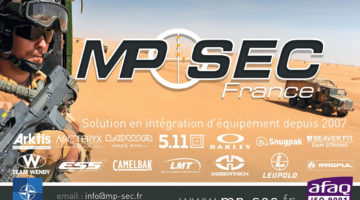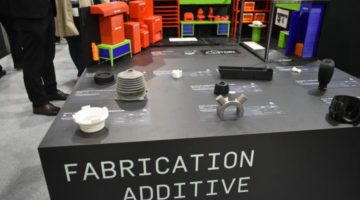By Pierre Tran – Ensuring European Sovereignty in Producing High-Performance IR Sensors*
A 10-strong European consortium is launching a four-year, €18 million ($19.8 million) project to select a common chip foundry to build next generation infrared sensors for military applications, said David Billon-Lanfrey, chief strategy officer of Lynred, which leads the group.
The European Defence Fund is backing the project, dubbed High Efficiency Read-Out Integrated Circuit (Heroic), providing €18 million ($19.8 million) in a total project budget of €19 million, Lynred said in a Jan. 10 statement.
“One overall aim is to enable Europe to gain technological sovereignty in producing high-performance IR sensors,” Lynred said in the statement.
The project consortium comprises three infrared component makers, industrial partners and research institutes, with the project starting this month. The defense fund is part of the European Union’s bid to boost military capabilities of the 27 member states by investing in upstream technology.
The project is a cooperative approach which brings together three IR component manufacturers, namely AIM from Germany, Lynred from France, and Xenics from Belgium. These companies, which compete with each other in components for electro-optical military kit, have formed the project partnership to boost competitiveness of the European IR industry.
“The main goal of the Heroic project is to validate for our specific infrared use a common advanced CMOS (complementary metal oxide semiconductors) foundry. That foundry could come from players such as STMicroelectronics and X Fab,” Lynred said.
STMicroelectronics is a Franco-Italian company, while X-Fab is a Belgian company.
The project consortium includes four system integrators, namely Indra of Spain, Miltech Hellas of Greece, Kongsberg of Norway, and PCO of Poland.
There is a component provider, namely Ideas – a Norwegian integrated circuit developer, and two research institutes – CEA-Leti of France and University of Seville of Spain.
A New Generation of IR sensors
The European project seeks to deliver a new generation of IR components packed with smaller pixels, to allow the detection and identification of targets at greater range, Billon-Lanfrey said.
A key aim is to reduce the size of pixels to five to eight microns from the present range of 10 to 15 microns.
The EU-backed project allows the three manufacturing companies to share a foundry – essentially a chip factory – based on advanced CMOS, to design and build components for more powerful IR sensors.
The manufacturers will each build a prototype IR sensor using the project’s foundry, once it has been selected and certified. That shared access is intended to allow building small numbers and meet specific needs, while seeking to secure a European supply chain.
European clients for IR components include Leonardo, Safran, and Thales, while U.S. contractors Raytheon, Lockheed Martin and L3 order infrared sensors.
There is early discussion on open access to IR components in the European supply chain, in the next stage for cooperation, Billon-Lanfrey said.
“The project’s main objectives are to increase access to, and dexterity in, using a new European-derived advanced CMOS technology that offers key capabilities in developing the next generations of high-performance infrared sensors – these will feature smaller pixels and advanced functions for defense applications,” Lynred said.
“Its commonly specified platform will allow each consortium partner to pursue its respective technological roadmap and more effectively meet the higher performance expectations of post-2030 defense systems,” the company said.
The present project marks the start of a European cooperative effort long sought by Sofradir, the predecessor to Lynred, formed in 2019 from the merger of Sofradir, which specialized in military IR components and its ULIS unit, which supplied civil applications.
Many years ago, there had been hopes of European cooperation between Sofradir, IS2 – the then U.K. unit of the Italian company Selex, and AIM. Selex has since rebranded as Leonardo.
But the Brexit departure of Britain appears to have made it complicated for a U.K. company to take part in a project backed by the E.U.
“The Heroic project will provide new advanced electrical components for the next generation IR sensors,” the European Defence Fund said on its website.
“The project ‘High Efficiency Read Out Circuits’ (HEROIC) will enable European IR sensor suppliers to sustainably design the next generation of EU Read-Out Integrated Circuit (ROIC) for IR sensors for defence applications,” the fund said.
Rainer Breiter, AIM vice president of IR-Module programs, said, “We are looking forward to working together with our partners in this common approach to access the latest advanced CMOS technology.”
“Xenics sees the Heroic project as a cornerstone for its strategy of SWIR (short-wave infrared) development for defense applications,” Paul Ryckaert, Xenics chief executive, said,
The European IR sector has attracted attention in mergers and acquisition.
Photonis, a French manufacturer of IR components, said Dec. 15 it had agreed the acquisition of Xenics for an undisclosed amount.
A French private equity company, HLD, acquired Photonis in 2021, after the latter had attracted M&A attention from Teledyne, based in Thousand Oaks, CA.
The U.S. company had been ready to pay €425 million for Photonis, after an initial valuation of €510 million, sparking French political concern over acquisition of sensitive French military technology by a U.S. company.
Lynred is a joint venture held equally by electronics company Thales and aero-engine manufacturer Safran.
More generally, the EU is seeking to promote common industrial standards, as can be seen in European legislation on the adoption of a standard USB plug for charging smartphones. That forces Apple to drop its iPhone Lightning connectors in the EU market in two years’ time.
* This article first appeared in SLDinfo.com, our partner website, and is re-published here with the latter’s authorization.












